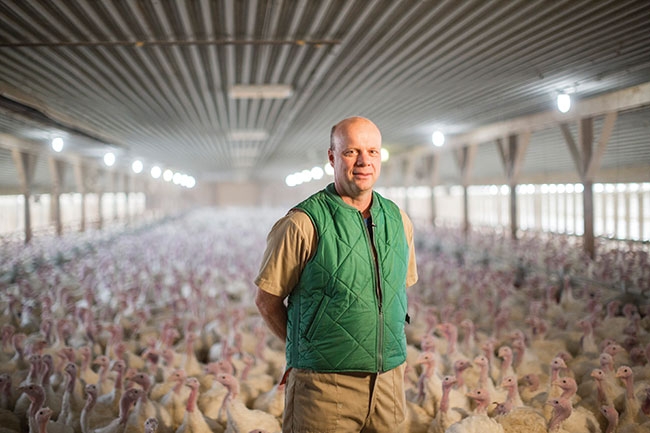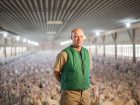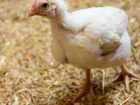
Food safety on poultry farms
By Karen Dallimore
Features Barn Management ProductionProducers and other experts share best practices.
 Mike Oegema, president of Oegema Turkey Farms, says litter management is key to on-farm food safety. PHOTO CREDIT: Oegema Turkey Farms
Mike Oegema, president of Oegema Turkey Farms, says litter management is key to on-farm food safety. PHOTO CREDIT: Oegema Turkey FarmsWhen you consider food safety, it’s easy to think of the kitchen – storing poultry properly, preparing it wisely and cooking it thoroughly. But the journey to safe food on our plates starts well before then. It actually begins on the farm. Canadian Poultry asked a few industry experts about how farm management practices contribute to food safety.
The following are five key takeaways from those discussions.
1. Litter management
The reality of poultry production and medicine is that we are working towards disease control to optimize food safety, animal wellbeing and performance, says Jess Walkey of Joyce Veterinary Services (JVS) in Hillsburgh, Ont. Working alongside well-known poultry veterinarian Mike Joyce, she points to flock immunity and litter quality as two areas of focus to reduce pathogen load and influence food safety as a result.
Flock immunity includes a health monitoring program, immunization, nutrition and management, Walkey explains. The effectiveness of vaccines is well established but it is litter management where she sees the most room for producers to make a difference.
As JVS states in its technical bulletin, “Managing litter [is] a critical control point for growing commercial poultry.” On day one, you’re dealing with baby birds, and babies of all species need to be kept dry and warm. This is something over which the barn manager has full control, influenced by decisions about the litter itself, ventilation and water management.
Walkey notes that wet litter translates into potential stressors such as increases in bacteria load, leg problems, encouraging the growth of molds and protozoa, and damage to skin and respiratory system through an increase in ammonia.
Shavings will reduce the risk of cellulitis; straw increases the risk of skin trauma. Walkey recommends a minimum of two inches, especially for concrete floors, to optimize absorption and provide comfort and warmth. Producers also need to consider ventilation from day one. After all, the veterinarian notes, it’s easier to keep litter dry than to dry out wet litter.
Oegema Turkey Farms president Mike Oegema shares Walkey’s sentiment about litter management. Based in Talbotville, Ont., Oegema Turkey Farms is a third-generation family operation started in 1958. It now grows approximately 55,000 turkeys per year. In 1992, the Oegema family started The Turkey Shoppe, offering turkey products to consumers directly from the farm.
For Oegema, drawing from his experience connecting both ends of the production spectrum, the key to on-farm food safety is straightforward. “The most effective management practice in the barn that contributes to food safety is simple – keep the litter clean,” he says.
Clean and dry litter prevents footpad sores and leads to better overall footpad health, he observes. If that means adding more fresh litter than usual during cold winter months then do so, Oegema suggests, noting that birds with better footpad health are more apt to move around to get food and water.
When it comes to harvesting the birds, well-managed litter means they move more easily to the loader or catchers and you will have less “unfit for harvest” birds left in the barn, the producer notes. At the processor you will have less condemns, which means more money ends up in your bank account.
2. Sanitation
Keith Warriner of the Department of Food Science at the University of Guelph in Guelph, Ont., is widely sought after as a source of information about food safety. He often preaches the importance of food preparers using different cutting boards for raw meat and using a meat thermometer to ensure food is thoroughly cooked.
When asked about what farmers could do to improve food safety, Warriner quickly points to sanitation and water decontamination to help minimize pathogen load.
Sanitation is the key part of the puzzle in the control of pathogens of concern to food safety and flock health, Warriner says. To many, good sanitation is often confused with visions of using strong sanitizers that you need a HAZMAT suit to apply. However, applying strong sanitizers cannot compensate for poor sanitary design or inconsistent procedures.
Barn design is key to successful sanitation with non-absorbent surfaces being used for construction, ensuring there are no inaccessible niches where pathogens could become established. Sanitary design also includes ensuring the facility is well maintained with no standing water or openings by which rodents can enter.
Warriner recommends producers prepare a standard sanitation operating procedure (SSOP) to outline a consistent sanitation process, following a sequence of removing soils and organics using a suitable detergent and then applying the sanitizing agent. One cannot sanitize surfaces through organic matter that provides physical protection for pathogens and also neutralizes the sanitizer.
Finally, the last step in the process is monitoring the sanitation performance through testing and plotting the data to analyze the trend. If the pathogen contamination trend is increasing then producers need to revise their sanitation plan. “To many, sanitation is a routine exercise,” Warriner says. “But in reality, it is a process of continual improvement and central to the health of the flock and reducing pathogens relevant to food safety.”
3. Water treatment
Pathogens such as Salmonella and Campylobacter can be readily transferred between birds via the water they drink, Warriner explains. Water can be contaminated at any point from the original source through to the final drinking nipple or bath.
Warriner’s preferred source of water is ground or municipal. He urges caution when using surface or rain water, as they can introduce pathogens.
Water can vary in the hardness and mineral content, which can directly impact flock health. However, hard water can also have indirect effects of causing scale formation in pipes that provide niches in which biofilms can become established. Therefore, in some areas it is beneficial to soften water prior to entering the facility.
Regardless of the source, producers need to sanitize all water, even municipal. There are techniques such as ozone and UV that inactivate pathogens but, importantly, do not retain residual antimicrobial activity enabling pathogens to survive then transfer bird-to-bird. Chemical sanitizers such as chlorine or acidifying agents have a long history in water treatment, however, byproducts such as odour are not highly toxic but can reduce water intake.
Warriner prefers sanitization through electrolyzed water, using a sanitizer that does not produce byproducts but also has residual antimicrobial activity. Although electrolyzed water must be generated on site, he has found it to be a valuable intervention in preventing pathogens being transferred via drinking water.
4. Ventilation
Al Dam, poultry specialist for the Ontario Ministry of Agriculture, Food and Rural Affairs, is a familiar face in the poultry industry in Ontario. He looks after the needs of birds from all commodities as well as artisanal flocks right across the province.
When asked for on-farm food safety advice, his list of management issues quickly grew. But as the main concern, he echoed other experts by focusing on litter quality – this time from a ventilation perspective.
Even when it’s really cold, keeping minimum ventilation is important, Dam says. The birds must also be kept within a comfortable temperature range, which may require adding heat to the barn. If the birds get too chilled then their energy goes to keeping warm instead of production, eating more but growing less.
Air flow controls the humidity as well as the temperature. The idea is to remove moisture and promote drying. Litter holds moisture well but once its capacity is reached you’ve lost it for the duration of the flock, Dam says.
Adding dry shavings or drying agents can help temporarily. But Dam suggests focusing onprevention such as proper minimal ventilation and repairing water leaks from drinking nipples or bells and keeping water lines high enough so birds do not spill water. Dry birds are healthy birds, meaning a safer product.
Food safety self-assessment
Reducing food safety risks begins at the farm level with good management, including:
- Practicing worker and visitor hygiene;
- Properly cleaning and sanitizing the barns;
- Treating, testing, and monitoring water;
- Proper handling of manure and compost; and
- Pest control.
Through Growing Forward 2, the Ontario Ministry of Agriculture, Food and Rural Affairs has created a series of self-assessment worksheets to help find gaps from a food safety perspective and contribute to creating an action plan for your farm. The assessment includes developing a system that will provide traceability and validate that control measures are effective.
To obtain a copy of the self-assessment, contact foodsafety@ontario.ca or call 1-877-424-1300.
Print this page


